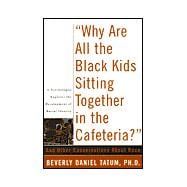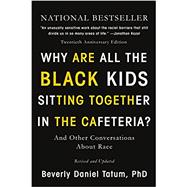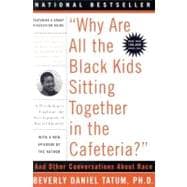Why Are All the Black Kids Sitting Together in the Cafeteria?

Why Are All the Black Kids Sitting Together in the Cafeteria?
- ISBN 13:
9780465091294
- ISBN 10:
0465091296
- Edition: Revised
- Format: Paperback
- Copyright: 06/24/1999
- Publisher: Basic Books
- Newer Edition
Rent
Sorry, this item is currently unavailable.
Note: Supplemental materials are not guaranteed with Rental or Used book purchases.
Extend or Purchase Your Rental at Any Time
Need to keep your rental past your due date? At any time before your due date you can extend or purchase your rental through your account.
Summary
Walk into any racially mixed high school and you will see Black youth seated together in the cafeteria. Of course, it's not just the Black kids sitting togetherthe White, Latino, Asian Pacific, and in some regions, American Indian youth, are clustered in their own groups, too. The same phenomenon can be observed in college dining halls, faculty lounges, and in corporate cafeterias.What is going on here? Is this self-segregation a problem we should try to fix, or a coping strategy we should support? How can we get past our reluctance to talk about racial issues to even discuss it? And what about the other questions we and our children have about race?Beverly Daniel Tatum is a renowned authority on the psychology of racism. She asserts that we do not know how to talk about our racial differences: Whites are afraid of using the wrong words and being perceived as "racist." Parents of color are afraid of exposing their children to painful racial realities too soon. Tatum understands that the vocabulary of race is loaded and that embarrassment and awkwardness often stymie conversations about this subject; yet, she believes that these obstacles can and must be overcome if we are to bring about change.In"Why Are All the Black Kids Sitting Together in the Cafeteria?" And Other Conversations About Race,Dr. Tatum provides us with a new way of thinking and talking about race through the lens of racial identity. She explains that all of us have a racial identity and must strive to affirm it. For people of color, the development of a constructive racial identity requires being able to recognize and reject the bombardment of negative stereotypes and to embrace a history of resistance and empowerment rather than passive victimization. For Whites, the challenge is to engage in a process of racial identity development which leads to an awareness of White privilege and a determination to actively work against injusticeand this requires the strength to reject a system that awards them, and to reclaim the legacy of White allies. For many, this is uncharted territory. This book provides a road map for those who want to make the journey and better understand the racial dynamics of their daily lives.Tatum extends her ideas about racial identity development beyond the usual Black-White paradigm to embrace the unique circumstances of Latinos, American Indians, Asians, as well as biracial youth. Also included is a list of resources for further reading as well as a list of books for parents and teachers to recommend to children of all ages.Using real-life examples and the latest research, Tatum presents strong evidence that straight talk about our racial identitieswhatever they may beis essential if we are serious about facilitating communication across racial and ethnic divides. We have waited far too long to begin our conversations about race. This remarkable book, infused with great wisdom and humanity, tells us where to start.











